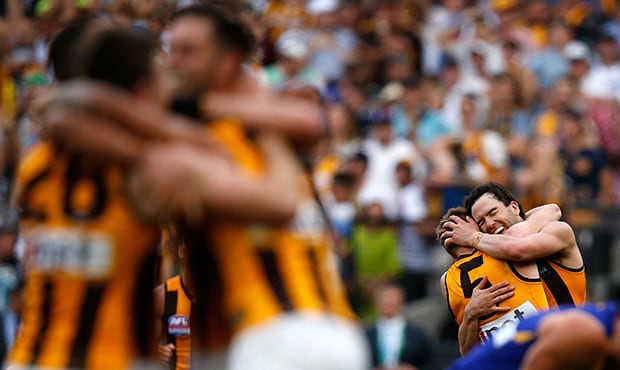• Keep track of the latest retirements, delistings and trades
• Indicative draft order: What picks will your club take to the draft?
• Ten things we learned from the Trade Period
• Sliding Doors: Trade Period wash-up
IN LESS complicated times a trade between AFL clubs would indicate how a player was valued in the market.
For instance West Coast swapped ruckman Callum Sinclair for Sydney Swans speedster Lewis Jetta at the end of 2015 and Collingwood traded Chris Dawes for pick No.20 at the end of 2012.
To the average footy fan, both deals seemed about right.
In simple terms, clubs traded with two basic commodities – players or draft picks.
However, such simplicity belongs to a bygone era with the introduction of academy points, the trading of future picks, free agency and the effect of compensation complicating matters.
Such matters have been discussed ad nauseam.
During the most recent NAB AFL Trade Period the rarely highlighted swapping of salary cap commitments began to dominate conversation behind closed doors enough to become the hidden agenda influencing several trade deals.
To be clear, this is not a new phenomenon but it's a practice that really emerged in 2016 as the salary cap squeeze began to hit clubs that once placed the importance of player retention above prudent accounting.
The prime example was Greater Western Sydney, with the expansion club staring at a massive blowout in its projected salary spend in 2017. And the other clubs knew it.
So North Melbourne, who found itself with a big hole in its own cap after the retirements of some well-paid stars, came knocking with the offer of pick 69 for midfielder Paul Ahern.
On the surface, the deal made little sense.
Although Ahern has had two knee reconstructions, he was good enough to be selection No.7 just two years ago. So unless he had depreciated more quickly than the British pound post-Brexit, he was worth more than the pick 69 offered by the Kangaroos.
However, with approximately $300,000 committed to him for 2017, when retention was the No.1 priority for Greater Western Sydney, the Giants were happy to offload him for next to nothing in return.
And North Melbourne was happy to take the punt on a 20-year-old talent for an exchange akin to one it would do for a free agent while spreading his contract over two years so it extended until the end of 2018.
Ditto Rhys Palmer being traded to Carlton for No.135: that's a NAB AFL Rising Star winner being sold as a penny stock.
The opposite forces were at work when it came to the trading of Tigers star Brett Deledio.
The Tigers weren't going to let the 29-year-old walk out the door without a significant return coming back the other way.
But they were prepared to pay a price to make it happen.
So with the Giants an interested buyer at the right price – and with a prized first-round pick available to Richmond in return – the two clubs needed to work out a deal satisfactory to both parties.
Industry sources suggest the Tigers agreed to pay about $150,000-200,000 a year of Deledio's wage (which was estimated to be $800,000 in 2017 if he stayed at the Tigers) over the next three years to get a deal over the line.
As a result Richmond gained next year's first-round pick (tied to Geelong's finishing position) and a future third-round pick.
It was not an unreasonable price for the Tigers to pay to be at the pointy end of the draft, albeit next season.
That's a good deal for both clubs with the Tigers bringing in new talent for Deledio and the Giants getting a very good player relatively cheaply, being able to absorb what the 29-year-old expected this season into a three-year deal.
Incidental to the mechanics of the trade, Deledio has agreed to less than he is probably worth in order to chase a flag.
Salary cap dealing was also the rationale behind Hawthorn – although the Hawks claim the motive was to assist their veterans to transition their careers – handballing club champions Sam Mitchell and Jordan Lewis to other clubs for a pick more worthy of castaways than premiership players.
The removal of the veterans' allowance would also have played a part in relinquishing these veterans that previously had a little more than $100,000 of their annual pay sitting outside the cap.
The salary cap played a part in Sam Mitchell and Jordan Lewis leaving the Hawks. Picture: AFL Photos
With 113 selections swapped and 38 players finding new homes, it was another turbo charged trade period.
But with no player-to-player swaps and seemingly crazy giveaways, it sometimes resembled a butcher's shop at closing time.
Underneath it all, behind free agents attracting headlines, disputes about compensation and the complications in the points bidding system, is a trading logic only understood when the salary cap implications of such deals are revealed.
Some relevant trades
1. Greater Western Sydney exchange Paul Ahern to North Melbourne for pick 69. AFL.com.au understands the former pick No.7 was contracted for about $300,000 in 2017, so the Kangaroos absorb that salary into a new two-year deal that better reflects his current value over the length of the contract.
2. Richmond exchange Brett Deledio to Greater Western Sydney for its on-traded future first-round selection (tied to Geelong) and its future third-round selection, but AFL.com.au understands the Tigers agreed to pay a proportion of Deledio's salary over the next three seasons.
3. Collingwood exchange Travis Cloke to the Western Bulldogs for pick 76. The Bulldogs absorb Cloke's estimated $400,000 wage for 2017 into a new two-year deal that better reflects his current value over the length of the deal.


